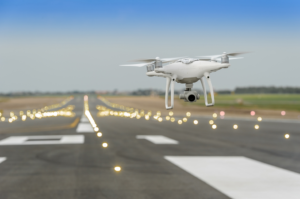U.S. enthusiast community watches closely as the Feds begin to propose new rules.
The following is a guest post from John Saginario: FPV flyer, writer and host of the Wild Flyers podcast.
As the partial government continues in the U.S. with no immediate end in sight, it appears the Federal Aviation Administration is wasting no time in laying the groundwork for new UAS regulations, which would impact hobbyist pilots as well.
As DroneLife has reported, DOT Secretary Elaine Chao recently announced the department’s new proposals (mainly directed at commercial UAS, but the rules would apply to hobbyist craft as well) to allow drones to fly at night, and over crowds of people, under certain controlled circumstances.
The FAA is also proposing those pilots be required to undergo additional testing and certification. Other proposed rules seek to research how best to incorporate UAVs into the national airspace, and ensure the public’s safety as the number of multicopters in the sky grows exponentially.
Certainly, opening up the skies and easing some restrictions are welcomed by the hobbyist community. In fact, the Academy of Model Aeronautics’ own safety guidelines go a step further than the proposed rules. The AMA rules forbid flying over people or crowds, and outline certain conditions for safe night flying.
“AMA’s safety guidelines allow night flying as long as a lighting system that provides the pilot with a clear view of the model’s attitude and orientation at all times is in place. We believe this policy continues to make sense and, at first glance, is similar to what the FAA is proposing,” says Chad Budreau, AMA Executive Director.
The AMA says it supports most of the FAA’s proposed regulations, but continues to be concerned about future rules that could hinder the otherwise safe hobby community.
“We continue to ask for FAA collaboration in adopting remote identification requirements that reflect the operational use of UAS – model aircraft, under AMA’s safety programming, pose no new risk to the airspace, therefore the remote identification rules for model aircraft operations should be more flexible,” Chad says.
Less-Friendly Skies
While the FAA drafts its new proposals, pilots in Canada are preparing for their own strict new regulations regarding UAVs. The laws, set to take effect this summer, require testing and certification under two classes of drone operation: basic or advanced. The laws also includes tighter restrictions for some commercial operators.
“Basic operations” covers most hobby and some commercial flights, and has few limits on what you can fly. Transport Canada does require drones and pilots to follow similar guidelines as the U.S.: craft must registered and weigh less than 55 pounds, stay under 400 feet and within line of sight, and avoid airports, events and emergency situations.
“Advanced operations” include licensed operators who plan to fly in controlled airspace, or over people. But the government has a much longer list of restrictions, including what type of drone you can operate. Transport Canada published a list, and there are no DJI products anywhere on it.
The new rules do carve out a small exception for some hobbyists who fly micro drones under 250 grams. A number of popular racing drones and micro quadcopters like the Emax Babyhawk R and the ultra-light Tiny Whoop fall well under that weight limit, so hobbyists can continue to enjoy flying in backyards and empty fields with little concern.
However, many drone enthusiasts would be quick to point out there’s no direct correlation between the size of a drone and the potential threat it could pose. A 300 gram quadcopter isn’t necessarily more dangerous than one that weighs 247 grams. In addition, the rules could make drone racing competitions with spectators more difficult or nearly impossible.
Ignoring the Real Problem
Of course, onerous regulations would do little to stop bad actors from using off-the-shelf technology, or building home-grown platforms, to commit dangerous acts. Until agencies develop better defense measures against rogue drones, more rules won’t necessarily make the skies safer.
Remote identification remains far from being ready to incorporate into every UAV, and it still must prove itself an effective way to control the airspace. In the meantime, governments must come up other solutions to mitigate drone risks, while enacting laws that promote safe operation from hobby and commercial pilots alike.
 John Saginario is the host of the Wild Flyers Podcast (www.soundcloud.com/wild-
John Saginario is the host of the Wild Flyers Podcast (www.soundcloud.com/wild-
https://dronelife.com/2019/01/22/hobbyist-view-faas-first-take-on-new-drone-regulations-and-strict-new-rules-in-canada/
 Unmanned Aerial Vehicle The latest drone news
Unmanned Aerial Vehicle The latest drone news




